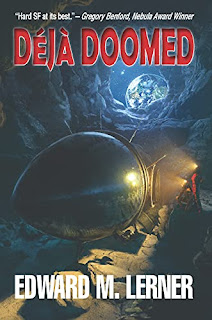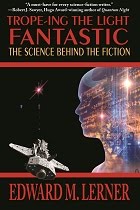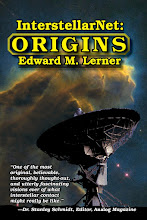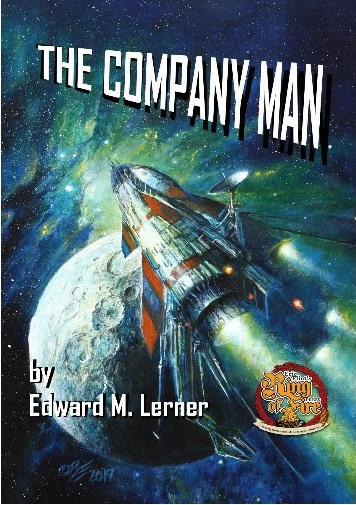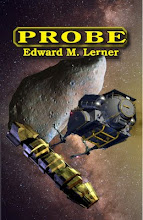Okay, not Kansas, exactly. Someplace homey. One of those myriads of "Class M" planets and moons with which the Star Trek universe is rife.
Can terrestrial planets give rise to alien aliens -- by which I mean, as proposed in early posts in this series, non-humanoids? Not people in rubber suits?
Of course: Think how varied life on Earth is. It's not much of a stretch to imagine intelligent dolphin-like creatures. They could evolve prehensile tongues and lips to remain streamlined and still be tool users. Or intelligent elephants -- they have prehensile trunks. Or tool-using (and perhaps larger, thus flightless) parrots. Or dinosaurs. If a big rock hadn't smacked into Earth, what might dinosaurs have given rise to by now?
What fictional alien aliens have we seen able to live on Earth? Equivalently, what fictional alien aliens have we seen on whose home worlds humans visit without special gear?
Larry Niven and Jerry Pournelle brought us the Fithp, wonderful elephant-like creatures (who coveted Earth), in Footfall. They brought us the even more wonderful, three-armed, greatly speciated, Moties of The Mote in God's Eye.
Niven also brought us the Pierson's Puppeteers, in several of his Known Space stories and books (to which, in some small part, I've recently contributed in two collaborations with Larry). Puppeteers are three-legged, two-headed herd creatures with mouths for hands -- and possessed of a ruthless cowardice of which other species best beware.
In A Fire Upon the Deep, Vernor Vinge brought us the delightful Tines, wolf-like creatures who -- communing with ultrasound -- form pack-like sapient group minds. Their technology remains primitive, limited by only cooperating mouths and muzzles for "hands."
Michael Flynn gave us the dimension-crossing, insectile Krenken (amid the Black Death in medieval Germany, no less) in Eifelheim.
Ted Chiang brought us heptapods in "Story of Your Life," possessors of a mindblowingly nonhuman perception of reality. (It's a wonderful story -- I've cited it before -- and I hate to say more. It won both Nebula and Sturgeon awards, and was nominated for a Hugo. Just go read it.)
So: We can have our cake (Earth-like planets, on which human characters roam, with whom readers can readily identify) and icing on it, too (alien aliens). I just wish it happened more often.
Thursday, January 29, 2009
Alien aliens (from Kansas)
Posted by
Edward M. Lerner
at
7:00 PM
Labels:
aliens,
ed's fiction,
known space,
science fiction,
sf
Monday, January 26, 2009
Just slightly ahead of our time
Last week's SF and Nonsense chat (thanks to everyone who dropped by!) visited several topics. Tropes in SF occupied much of the back-and-forth, and what makes a fictional alien interesting, and whether tropes are good or bad things, and what fraction of SF readers welcome -- or shun -- scientific rigor. Large swathes of the nominally SF section of bookstores are alternate history, or scientific fantasy, or high fantasy, or oaters in space, or ... darn near anything but SCIENCE fiction.
Which led briefly to a related literary form: the techno-thriller. Arguably the techno-thriller is science fiction -- the type of SF with its science/tech front and center. No fantasy, no hand waving, no magic -- just stuff that works or very plausibly can be extrapolated from what we already know to work. Think Michael Crichton, (some) Tom Clancy, Dale Brown, Stephen Coonts, Robin Cook ....
By most definitions of science fiction, science must be, somehow, integral to the story. That said, science's role may be metaphorical or tangential or stage setting.
As with so-called hard SF (hard meaning scientifically rigorous), tech -- and lots of it -- is integral to the techno-thriller. The techno-thriller reader grooves on technical description. Techno-thrillers can (to some tastes) overdo the digression into neat techno-toys, but description is expected. Perhaps because these stories are grounded in today's cutting-edge tech, techno-thrillers are generally -- I want to say always, but someone will surely cite an exception -- near future. (See, there is meaning to this post's subject. I merely took longer than usual to get there.)
By their content, techno-thrillers could be considered SF. By marketing and convention (and location at the bookstore), techno-thrillers are positioned as a separate genre. And yet hard SF and techno-thrillers logically speak to similar readers.
Much of my writing straddles the fence. In fact, I have declared myself a "perpetrator of science fiction and techno-thrillers."
What say you? Are techno-thrillers SF marketed differently? Or are techno-thrillers a genre all their own?
Our operators are standing by ...
Which led briefly to a related literary form: the techno-thriller. Arguably the techno-thriller is science fiction -- the type of SF with its science/tech front and center. No fantasy, no hand waving, no magic -- just stuff that works or very plausibly can be extrapolated from what we already know to work. Think Michael Crichton, (some) Tom Clancy, Dale Brown, Stephen Coonts, Robin Cook ....
By most definitions of science fiction, science must be, somehow, integral to the story. That said, science's role may be metaphorical or tangential or stage setting.
As with so-called hard SF (hard meaning scientifically rigorous), tech -- and lots of it -- is integral to the techno-thriller. The techno-thriller reader grooves on technical description. Techno-thrillers can (to some tastes) overdo the digression into neat techno-toys, but description is expected. Perhaps because these stories are grounded in today's cutting-edge tech, techno-thrillers are generally -- I want to say always, but someone will surely cite an exception -- near future. (See, there is meaning to this post's subject. I merely took longer than usual to get there.)
By their content, techno-thrillers could be considered SF. By marketing and convention (and location at the bookstore), techno-thrillers are positioned as a separate genre. And yet hard SF and techno-thrillers logically speak to similar readers.
Much of my writing straddles the fence. In fact, I have declared myself a "perpetrator of science fiction and techno-thrillers."
What say you? Are techno-thrillers SF marketed differently? Or are techno-thrillers a genre all their own?
Our operators are standing by ...
Posted by
Edward M. Lerner
at
5:24 PM
Labels:
business of writing,
chat,
ed's fiction,
science fiction,
sf,
technothriller,
trope
Saturday, January 24, 2009
Alien aliens (from alien places)
Some of the most memorable aliens in SF (speaking only of my memory, of course -- your mileage may vary) come from non-Earthlike planets. Maybe that's because the less Earthlike the alien homeworld, the harder it is to make its denizens people in rubber suits. Fictional humanoid aliens are so commonplace they tend to blur together.
So what books, settings, and aliens am I remembering? To name a few:
Mission of Gravity, by Hal Clement (Harry Stubbs). The very-fast-spinning -- and hence, far from spherical -- planet Mesklin has surface gravity varying from a few gees at the equator to hundreds of gees at the poles. The centipede-like natives are the stars -- practically the only characters -- of the novel.
A Deepness in the Sky, by Vernor Vinge. The "on-off" star of this solar system leads to a world plunged regularly into cryogenic temperatures. Its atmosphere freezes out on a regular basis. The natives look a bit like spiders and hibernate like -- well, there's no close terrestrial parallel.
Titan, by John Varley. The main alien IS a terrestrial (sort-of) world.
I'm NOT saying that the only good SFnal aliens are nonhumanoid aliens. That said, I can't help but be struck by how much more vivid nonhumanoid aliens are in my memory.
Have I tried to do aliens who can't even live around humans? I'm glad you asked. Among my contributions to Fleet of Worlds (a collaboration with Larry Niven) is the Gw'oth. The Gw'oth play a small but pivotal role in Fleet of Worlds and move to center stage in our forthcoming Destroyer of Worlds.
Gw'oth (that's the plural; one is a Gw'o) live around deep-sea vents, beneath the ice of a moon like Europa. A Gw'o looks a bit like a starfish crossed with an octopus. Its limbs are hollow (aka, "tubacles"), because the Gw'oth descend from colonies of carnivorous sea worms. A legacy of their colony-form origins plays a big role in ... well, every story in which they appear. (Less crypticism would be a spoiler.)
That's the larger point of this post: Exotic settings beget alien creatures beget novel circumstances encourage memorability. Fiction attains memorability by many paths, of course ... but for this post, I'm content to celebrate a particular path.
So what books, settings, and aliens am I remembering? To name a few:
Mission of Gravity, by Hal Clement (Harry Stubbs). The very-fast-spinning -- and hence, far from spherical -- planet Mesklin has surface gravity varying from a few gees at the equator to hundreds of gees at the poles. The centipede-like natives are the stars -- practically the only characters -- of the novel.
A Deepness in the Sky, by Vernor Vinge. The "on-off" star of this solar system leads to a world plunged regularly into cryogenic temperatures. Its atmosphere freezes out on a regular basis. The natives look a bit like spiders and hibernate like -- well, there's no close terrestrial parallel.
Titan, by John Varley. The main alien IS a terrestrial (sort-of) world.
I'm NOT saying that the only good SFnal aliens are nonhumanoid aliens. That said, I can't help but be struck by how much more vivid nonhumanoid aliens are in my memory.
Have I tried to do aliens who can't even live around humans? I'm glad you asked. Among my contributions to Fleet of Worlds (a collaboration with Larry Niven) is the Gw'oth. The Gw'oth play a small but pivotal role in Fleet of Worlds and move to center stage in our forthcoming Destroyer of Worlds.
Gw'oth (that's the plural; one is a Gw'o) live around deep-sea vents, beneath the ice of a moon like Europa. A Gw'o looks a bit like a starfish crossed with an octopus. Its limbs are hollow (aka, "tubacles"), because the Gw'oth descend from colonies of carnivorous sea worms. A legacy of their colony-form origins plays a big role in ... well, every story in which they appear. (Less crypticism would be a spoiler.)
That's the larger point of this post: Exotic settings beget alien creatures beget novel circumstances encourage memorability. Fiction attains memorability by many paths, of course ... but for this post, I'm content to celebrate a particular path.
Posted by
Edward M. Lerner
at
9:50 PM
Labels:
aliens,
ed's fiction,
Gw'oth,
Larry Niven,
science fiction,
sf
Thursday, January 22, 2009
Chat: a noble experiment
Just a reminder ... the first SF and Nonsense chat will be held Saturday 1/24, beginning (or at least I'll be checking in) at 4:00 p.m. ET.
See the chat announcement for details.
I hope to see you there.
See the chat announcement for details.
I hope to see you there.
Posted by
Edward M. Lerner
at
11:00 AM
Labels:
anti-science,
business of writing,
chat,
ed's fiction,
science,
science fiction,
sf,
trope
Tuesday, January 20, 2009
A new beginning, or déjà vu?
Among the consequences of the new presidential administration is a change at the helm of NASA. The latest administrator, Michael Griffin, leaves office today. As I write, a new administrator has not been nominated (although of course rumors fly).
Will the change be for good or ill, I wonder? Or more of the uninspiring same?
NASA has been, IMO, adrift for a long time. The international space station is a a money sink seemingly without a mission beyond completion. The ill-fated, soon-to-be-retired shuttle program has been another money sink, with little purpose beyond completing the ISS. The Constellation program is busily rediscovering everything the Apollo program learned.
Robotic science missions have, in general, fared much better in recent years. The Hubble Space Telescope, the Mars rovers, the Cassini-Huygens mission ... merely to think of them (among many) brings a smile to my face.
So am I advocating against human space flight? Absolutely, positively, NOT. As Griffin stated in 2004, "For me the single overarching goal of human space flight is the human settlement of the solar system, and eventually beyond. I can think of no lesser purpose sufficient to justify the difficulty of the enterprise, and no greater purpose is possible."
To Griffin's words I'll add: We need space to inspire young minds, as an impetus to new scientific and technological discoveries, as a new frontier, as a source of new resources, as a place to manufacture goods and to produce energy without polluting our home planet, and as insurance against planetary disaster.
We need consistency of purpose -- and a bit of investment -- to get there.
We American taxpayers are collectively on the hook for staggering amounts in bailouts, debt guarantees, and stimulus payments, with new commitments on the way. New investments in space technology and exploration strike me as far worthier, and often cheaper -- and certainly more forward looking -- than the trillion bucks, more or less, Washington seems ready to spend to clean up past messes. As too often gets lost in the shuffle: Any money that gets spent for space is spent on Earth.
Let's find our way back to the future.
Will the change be for good or ill, I wonder? Or more of the uninspiring same?
NASA has been, IMO, adrift for a long time. The international space station is a a money sink seemingly without a mission beyond completion. The ill-fated, soon-to-be-retired shuttle program has been another money sink, with little purpose beyond completing the ISS. The Constellation program is busily rediscovering everything the Apollo program learned.
Robotic science missions have, in general, fared much better in recent years. The Hubble Space Telescope, the Mars rovers, the Cassini-Huygens mission ... merely to think of them (among many) brings a smile to my face.
So am I advocating against human space flight? Absolutely, positively, NOT. As Griffin stated in 2004, "For me the single overarching goal of human space flight is the human settlement of the solar system, and eventually beyond. I can think of no lesser purpose sufficient to justify the difficulty of the enterprise, and no greater purpose is possible."
To Griffin's words I'll add: We need space to inspire young minds, as an impetus to new scientific and technological discoveries, as a new frontier, as a source of new resources, as a place to manufacture goods and to produce energy without polluting our home planet, and as insurance against planetary disaster.
We need consistency of purpose -- and a bit of investment -- to get there.
We American taxpayers are collectively on the hook for staggering amounts in bailouts, debt guarantees, and stimulus payments, with new commitments on the way. New investments in space technology and exploration strike me as far worthier, and often cheaper -- and certainly more forward looking -- than the trillion bucks, more or less, Washington seems ready to spend to clean up past messes. As too often gets lost in the shuffle: Any money that gets spent for space is spent on Earth.
Let's find our way back to the future.
Friday, January 16, 2009
Alien aliens (let's get physical)
Easy things first ... how should aliens look?
Well, most likely alien. Even (as in this post) aliens who evolved on Earthlike planets.
That's not to say they shouldn't ever share some anatomical features with terrestrial life. What works on Earth remains our only data point for what can work. That said, even terrestrial life shows more variety than some SF aliens.
Take bilateral symmetry with four limbs. Yes, many earthly animals follow that design. For most of us, left/right symmetry and four limbs were inherited from very primitive ancestors. Had we descended from starfish or octopi -- and given a different timing of inopportune asteroid strikes, that might have happened -- we would look a lot different.
Adding or removing a limb is an improvement on the Lerner alien-o-meter scale. The Puppeteers of Larry Niven's Known Space have three legs and two necks/arms. They remain left/right symmetric. The third/rear leg is markedly different from the front two, leading to distinct front and back. So in that way, not entirely alien ...
(Full disclosure: I co-write about Puppeteers, and I feel I've made contributions to their sociology. Their physiology was defined before I came onto the scene.)
Let's go further, with some symmetry breaking. My 2005 novel Moonstruck involves aliens called the Krulirim. A Krul's three limbs serve as arms and legs. It has three sensory clusters, also equally spaced. Picture a Weber kettle BBQ grill (the charcoal kind, for those of us who like to make fire) with hands -- though not quite like human hands -- at the end of its tripod legs.
A Krul has no notion of left or right, of front or back. Its worldview is radially symmetric. Unless a Krul is asleep, you can't sneak up on it. Nothing nearby is out of its sight. You or I might refer to an object by its distance to one side or another, and the distance in front or behind us -- basically, Cartesian coordinates, centered on our own body. That doesn't work for a Krul. So a Krul locates objects via polar coordinates: the distance from the body and the angle from a reference point.
"Aha!" you say. If a Krul is radially symmetric, how does it define that reference point? It needs an out-of-body reference point, so I gave Krulirim a magnetic sense. The reference for angular measurements is the bearing on the magnetic pole. (Terrestrial birds navigate magnetically. Why not Krulirim?) Two Krulirim comparing notes on the location of an object have to do trig in their minds.
This body plan made the aliens have an unfamiliar-to-us worldview and required a sensory mode only weakly present, if at all, in most terrestrial life. These bodily features wound up driving some plot points (I'll omit spoilers, in case I've made anyone curious). The Krul body design also gave me a real workout, trying to eradicate every reference to front, back, and sides that crept into the narrative because they're endemic to our language.
So, Guideline One: Alien aliens look alien.
Well, most likely alien. Even (as in this post) aliens who evolved on Earthlike planets.
That's not to say they shouldn't ever share some anatomical features with terrestrial life. What works on Earth remains our only data point for what can work. That said, even terrestrial life shows more variety than some SF aliens.
Take bilateral symmetry with four limbs. Yes, many earthly animals follow that design. For most of us, left/right symmetry and four limbs were inherited from very primitive ancestors. Had we descended from starfish or octopi -- and given a different timing of inopportune asteroid strikes, that might have happened -- we would look a lot different.
Adding or removing a limb is an improvement on the Lerner alien-o-meter scale. The Puppeteers of Larry Niven's Known Space have three legs and two necks/arms. They remain left/right symmetric. The third/rear leg is markedly different from the front two, leading to distinct front and back. So in that way, not entirely alien ...
(Full disclosure: I co-write about Puppeteers, and I feel I've made contributions to their sociology. Their physiology was defined before I came onto the scene.)
Let's go further, with some symmetry breaking. My 2005 novel Moonstruck involves aliens called the Krulirim. A Krul's three limbs serve as arms and legs. It has three sensory clusters, also equally spaced. Picture a Weber kettle BBQ grill (the charcoal kind, for those of us who like to make fire) with hands -- though not quite like human hands -- at the end of its tripod legs.
A Krul has no notion of left or right, of front or back. Its worldview is radially symmetric. Unless a Krul is asleep, you can't sneak up on it. Nothing nearby is out of its sight. You or I might refer to an object by its distance to one side or another, and the distance in front or behind us -- basically, Cartesian coordinates, centered on our own body. That doesn't work for a Krul. So a Krul locates objects via polar coordinates: the distance from the body and the angle from a reference point.
"Aha!" you say. If a Krul is radially symmetric, how does it define that reference point? It needs an out-of-body reference point, so I gave Krulirim a magnetic sense. The reference for angular measurements is the bearing on the magnetic pole. (Terrestrial birds navigate magnetically. Why not Krulirim?) Two Krulirim comparing notes on the location of an object have to do trig in their minds.
This body plan made the aliens have an unfamiliar-to-us worldview and required a sensory mode only weakly present, if at all, in most terrestrial life. These bodily features wound up driving some plot points (I'll omit spoilers, in case I've made anyone curious). The Krul body design also gave me a real workout, trying to eradicate every reference to front, back, and sides that crept into the narrative because they're endemic to our language.
So, Guideline One: Alien aliens look alien.
Posted by
Edward M. Lerner
at
3:37 PM
Labels:
aliens,
ed's fiction,
first contact,
puppeteer,
science fiction,
sf
Tuesday, January 13, 2009
Alien aliens (an introduction)
Too many SFnal aliens aren't really SFnal at all.
Many "aliens" are (in the video format, literally) people in rubber suits and makeup. That's fine where the story is as much allegory or satire as SF -- see my post on trope aliens. It's far from fine when we want to broaden our horizons a bit. After all, isn't one of the joys of SF broadened horizons?
Some argue truly alien aliens don't work in stories. If the author succeeds in portraying a truly alien alien, the reader won't be able to relate. Agreed: that can happen. It doesn't have to, as can be proven by example.
That is, some wildly popular pieces of fiction involve truly alien aliens. To name a few:
* The Buggers of Orson Scott Card's Ender's Game series.
* The Puppeteers of Larry Niven's Known Space.
* The pack-intelligent Tines of Vernor Vinge's A Fire Upon the Deep.
* The uplifted dolphins of David Brin's Uplift War series.
In this new series of posts, I'll be looking at alien aliens. Some of the above examples will surely crop up. So will aliens I've perpetrated in my own writing.
Will the aliens to be discussed have any characteristics in common with humans? Most likely. Common physical-world constraints and similar (not necessarily identical) evolutionary pressures may lead to some shared attributes. Beings able to take a holiday from physics and biology would be truly alien -- but they wouldn't be believable.
Stay tuned.
Many "aliens" are (in the video format, literally) people in rubber suits and makeup. That's fine where the story is as much allegory or satire as SF -- see my post on trope aliens. It's far from fine when we want to broaden our horizons a bit. After all, isn't one of the joys of SF broadened horizons?
Some argue truly alien aliens don't work in stories. If the author succeeds in portraying a truly alien alien, the reader won't be able to relate. Agreed: that can happen. It doesn't have to, as can be proven by example.
That is, some wildly popular pieces of fiction involve truly alien aliens. To name a few:
* The Buggers of Orson Scott Card's Ender's Game series.
* The Puppeteers of Larry Niven's Known Space.
* The pack-intelligent Tines of Vernor Vinge's A Fire Upon the Deep.
* The uplifted dolphins of David Brin's Uplift War series.
In this new series of posts, I'll be looking at alien aliens. Some of the above examples will surely crop up. So will aliens I've perpetrated in my own writing.
Will the aliens to be discussed have any characteristics in common with humans? Most likely. Common physical-world constraints and similar (not necessarily identical) evolutionary pressures may lead to some shared attributes. Beings able to take a holiday from physics and biology would be truly alien -- but they wouldn't be believable.
Stay tuned.
Friday, January 9, 2009
Uncertainty
Quantum mechanics -- the arcane branch of physics that governs the atomic and subatomic realms -- means something. It must: It led us to transistors, solar cells, quantum cryptography, and lots of other wondrous stuff . But what it means has been a matter of debate for almost a century.
My ages-ago QM classes were taught by professors of the "shut up and calculate" school. As in: Don't ask what it all means. Just know that it works. That, alas, never worked for me.
It's not like I have the answer, but I do read about QM from time to time. I've just finished an outstanding book on the subject. It's Uncertainty: Einstein, Heisenberg, Bohr, and the Struggle for the Soul of Science, written by physicist David Lindley.
To take just one thing the book makes wonderfully clear, it is why such giants of modern physics would fight over an increasingly successfully mathematical description: its implications. To embrace the math at face value was to accept a change from determinacy (that whatever scientists observe follows from a knowable -- if not necessarily known -- cause) to probability (that events at the atomic level have a chance of happening, but when they will, and why they will, are unknowable). As in: Why does a particular electron change energy states now? Why not, say, a second from now? Or equivalently: Why does a particular uranium atom decay now, and not in a thousand years?
Without determinacy, we lose -- or at the least, we redefine -- cause and effect. That's a large implication normally glossed over by abstruse mathematics -- and certainly glossed over when QM is taught by the "shut up and calculate" method.
Highly recommended.
My ages-ago QM classes were taught by professors of the "shut up and calculate" school. As in: Don't ask what it all means. Just know that it works. That, alas, never worked for me.
It's not like I have the answer, but I do read about QM from time to time. I've just finished an outstanding book on the subject. It's Uncertainty: Einstein, Heisenberg, Bohr, and the Struggle for the Soul of Science, written by physicist David Lindley.
To take just one thing the book makes wonderfully clear, it is why such giants of modern physics would fight over an increasingly successfully mathematical description: its implications. To embrace the math at face value was to accept a change from determinacy (that whatever scientists observe follows from a knowable -- if not necessarily known -- cause) to probability (that events at the atomic level have a chance of happening, but when they will, and why they will, are unknowable). As in: Why does a particular electron change energy states now? Why not, say, a second from now? Or equivalently: Why does a particular uranium atom decay now, and not in a thousand years?
Without determinacy, we lose -- or at the least, we redefine -- cause and effect. That's a large implication normally glossed over by abstruse mathematics -- and certainly glossed over when QM is taught by the "shut up and calculate" method.
Highly recommended.
Monday, January 5, 2009
A little gossip, a little chat
(Updated June 17, 2012) This post has become of historical interest only ... the chat log lived on someone else's website and is now overcome by events. But if chatting is your thing, check out my new discussion group at Goodreads).
A little idle talk of SF and Nonsense (with apologies to Joe Darion).
Last year's blog poll showed interest in an SF and Nonsense online chat. Let's give it a try, shall we? Saturday, 1/24/09, starting at 4:00 p.m. Eastern Time (that's GMT - 5 hours).
To access the chat, go to the Edward M. Lerner IRC chat server. Holler if you have questions.
Judging from comments on blog posts, I'll anticipate a few likely topics -- not to insist on them, but to prime the conversational pump: SF tropes, what we like (and don't) about popular SF series on TV, fandom, and my own fiction.
Whether or not you voted, I hope you'll join the fun.
A little idle talk of SF and Nonsense (with apologies to Joe Darion).
Last year's blog poll showed interest in an SF and Nonsense online chat. Let's give it a try, shall we? Saturday, 1/24/09, starting at 4:00 p.m. Eastern Time (that's GMT - 5 hours).
To access the chat, go to the Edward M. Lerner IRC chat server. Holler if you have questions.
Judging from comments on blog posts, I'll anticipate a few likely topics -- not to insist on them, but to prime the conversational pump: SF tropes, what we like (and don't) about popular SF series on TV, fandom, and my own fiction.
Whether or not you voted, I hope you'll join the fun.
Posted by
Edward M. Lerner
at
5:00 PM
Labels:
anti-science,
business of writing,
chat,
ed's fiction,
science,
science fiction,
sf,
trope,
welcome
Saturday, January 3, 2009
2009: The Year of Science
2009 happens to be the 200th anniversary of Darwin's birth (and the 150th anniversary of the publication of his On the Origin of Species). It's the 400th anniversary of Galileo's first use of the telescope for astronomy. It's the 100th anniversary of the discovery of the Burgess Shale fossil beds.
In recognition of these (and other) science-related anniversaries falling this year, the Coalition on the Public Understanding of Science has organized a year-long celebration of science. (COPUS was organized by the American Institute of Biological Sciences, the Geology Society of America, the University of California Museum of Paleontology, and the National Science Teachers Association. More than 400 other groups -- universities, museums, scientific societies, and the like -- participate.)
That leads us to 2009: The Year of Science. Each month YoS will celebrate a particular theme. January's theme, appropriately, is the process and nature of science itself. The YoS website is the hub of a great social network of participating organizations and events.
YoS is a worthy endeavor with noble goals: reminding us what science does for society and trying to rekindle popular interest in science. YoS officially kicks off today, in Boston, in coordination with the annual meeting of the Society of Integrative and Comparative Biology.
Check it out.
In recognition of these (and other) science-related anniversaries falling this year, the Coalition on the Public Understanding of Science has organized a year-long celebration of science. (COPUS was organized by the American Institute of Biological Sciences, the Geology Society of America, the University of California Museum of Paleontology, and the National Science Teachers Association. More than 400 other groups -- universities, museums, scientific societies, and the like -- participate.)
That leads us to 2009: The Year of Science. Each month YoS will celebrate a particular theme. January's theme, appropriately, is the process and nature of science itself. The YoS website is the hub of a great social network of participating organizations and events.
YoS is a worthy endeavor with noble goals: reminding us what science does for society and trying to rekindle popular interest in science. YoS officially kicks off today, in Boston, in coordination with the annual meeting of the Society of Integrative and Comparative Biology.
Check it out.
Subscribe to:
Posts (Atom)






